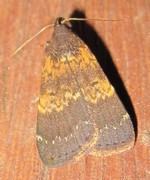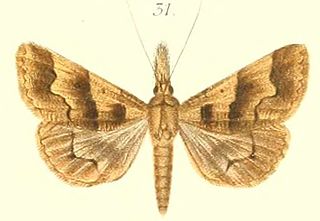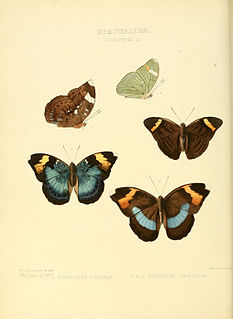
Poritiinae is a subfamily of butterflies, the larvae of which are unusual for feeding on algae and foliate lichen.

Hypochrysops is a genus of butterflies in the family Lycaenidae first described by Cajetan Felder and Rudolf Felder in 1860. This particular genus is exclusive to the Australian area with only a few species straying into Papua New Guinea.
George Thomas Bethune-Baker was an English entomologist who specialised in Lepidoptera, especially those in the family Lycaenidae of butterflies.
Oeonosia is a genus of moths in the family Erebidae described by George Hampson in 1914.
Aneliopis is a genus of moths of the family Erebidae. The genus was erected by George Thomas Bethune-Baker in 1908. All the species are known from New Guinea.
Cheillophota is a genus of moths of the family Erebidae. The genus was erected by George Thomas Bethune-Baker in 1908. All of the species are found in New Guinea.
Foveades is a genus of moths of the family Erebidae. The genus was erected by George Thomas Bethune-Baker in 1908.

Hydrillodes is a genus of litter moths of the family Erebidae first described by Achille Guenée in 1854. Its validity is somewhat disputed.

Ophyx is a genus of moths of the family Erebidae.
Parilyrgis is a genus of moths of the family Erebidae. The genus was erected by George Thomas Bethune-Baker in 1908.

Euproctis is a genus of tussock moths in the family Erebidae described by Jacob Hübner in 1819. Species are cosmopolitan, widespread throughout Palearctic, African, Oriental and Australian regions. Molecular phylogenetic studies indicate that the genus as presently understood comprises a large number of unrelated lineages, only a few of which have names, and is therefore in serious need of revision.
Pseudophyllodes is a genus of moths in the family Lasiocampidae. The genus was erected by George Thomas Bethune-Baker in 1910.
James Franklin Bethune-Baker was the Lady Margaret's Professor of Divinity at the University of Cambridge from 1891 to 1935.
Rivula biagi is a moth of the family Erebidae first described by George Thomas Bethune-Baker in 1908. It is known from New Guinea and the Australian state of Queensland.

Bebearia is a genus of brush-footed butterflies. The species are confined to the Afrotropical realm, mainly in the Guinean Forests of West Africa and the Congolian forests.
Alpenus nigropunctatus is a moth of the family Erebidae. It was described by George Thomas Bethune-Baker in 1908. It is found in Ghana, Nigeria, Sudan, Somalia, Ethiopia, Kenya and Uganda.
Cotana is a genus of moths in the family Eupterotidae.





